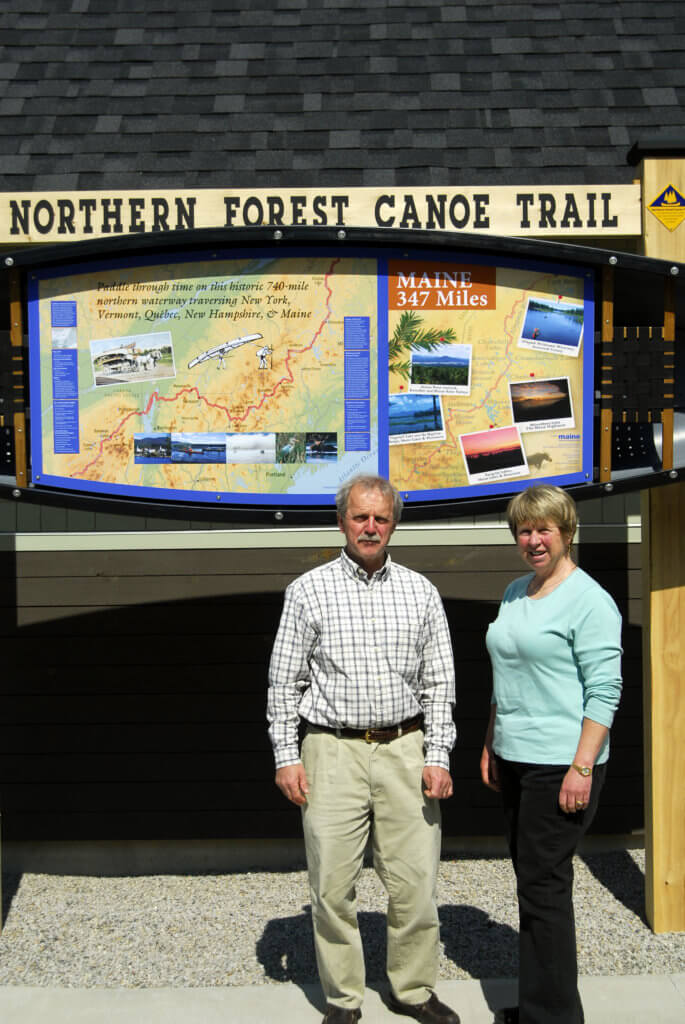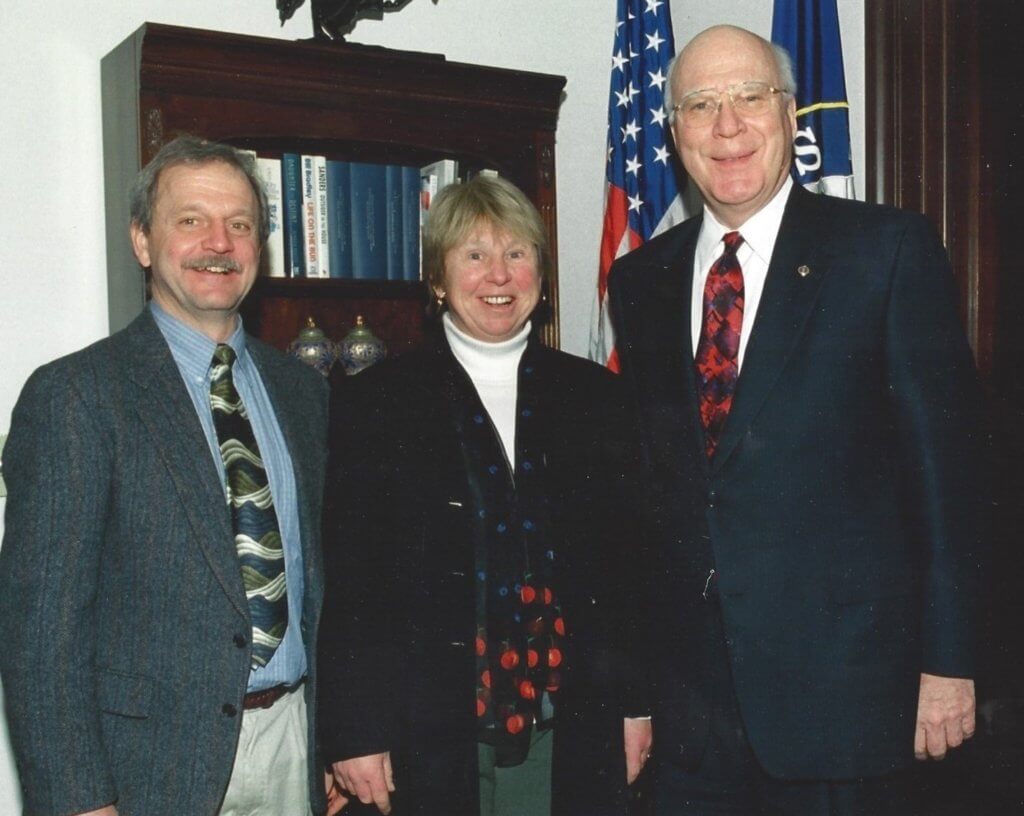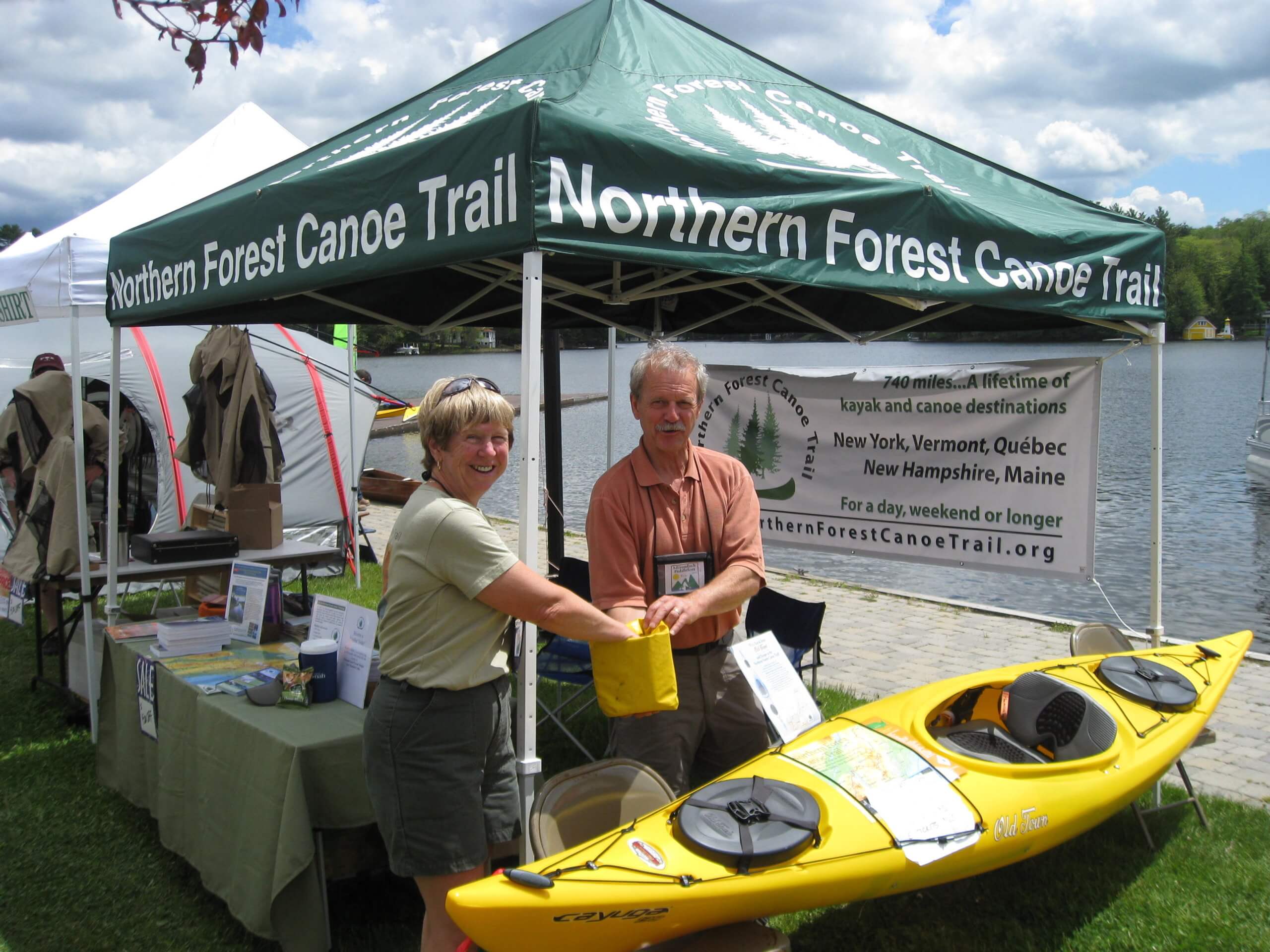As the Northern Forest Canoe Trail celebrates its 20th anniversary, we’re sharing stories that highlight the progress the trail and our organization have made over the last two decades. Earlier this year, we interviewed Kay Henry and Rob Center for part one of a three-part series exploring NFCT’s past, present and future.
Part one explored the years leading up to the NFCT’s founding. In this installment, we explore the early days of the organization. Stay tuned for part three!
No single person or persons “founded” the Northern Forest Canoe Trail — the rivers, lakes, ponds, streams and portages that comprise the 740-mile water trail from Old Forge, NY, to Fort Kent, Maine, have been here forever, as part of the homelands of the Wabanaki people and later used by settlers and travelers.
But the organization tasked with stewarding, mapping, and promoting the trail didn’t come into existence until 2000, thanks to the tireless efforts of Kay Henry and Rob Center.
The duo’s roots in the world of paddling run deep. Henry co-founded Mad River Canoe in the early 1970s, and Center joined the team in 1984 after years of running a cross-country ski center in Vermont. Through Mad River Canoe, Henry and Center promoted adventure paddling across the globe, but realized they weren’t highlighting opportunities close to home. Around that time, they connected with Native Trails and the work of Ron Canter, Mike Krepner, and Randy Madres, who were piecing together historic water trails in the Americas.
In 1999 after Henry had sold Mad River Canoe, a plan to create a nonprofit and crystalize the Northern Forest Canoe Trail took shape between Native Trails and Rob and Kay.
“From the beginning, we had this huge goal of making this an inland water trail of national significance,” Henry said. “We wanted to do it in a quality way that would last and be inclusive of the communities along the trail.”
A legal firm contributed services pro bono, and a 501c3 was established in 2000. Henry started recruiting a board of directors, while Center began organizing in communities across the four states.
“The original intent of the organization was to renew the bonds between people and water in the Northern Forest,” Center said. “Our goal was to re-establish a long distance recreational water trail as a living reminder of the history and heritage of this region. That message really resonated in our outreach — fascination with this ribbon of water, the land, and its occupants that’s evolved over time.”
To succeed across such a vast landscape, the NFCT had to develop trust with communities and partner organizations. Making inroads with the paddling community was easy enough — but to engage a broader group of stakeholders, Center and Henry needed a business plan that went beyond recreation.
“Our mission was — and is — unique,” Henry said. “It blends recreation, conservation and economic development. That’s not an easy thing to get your arms around.”
Initial funding from outdoor industry stalwarts played a big role in launching the NFCT— L.L. Bean, Old Town Canoe and Kayak, Perception Kayak and Timberland chief among them.
“That money helped us get materials for mailers to contact donors,” Center said. “Those four companies got our cash flow going, putting us in the black from day one.”
 Financial support was just one piece of the puzzle. In late 2000, the National Park Service Rivers Trails and Conservation Assistance Program (RTCA) stepped in to provide technical support to the NFCT, with leadership from a team of staffers who worked across four states. This team worked with Rob to find funding sources, build membership and contributions, computerize maps and enhance communications with paddlers.
Financial support was just one piece of the puzzle. In late 2000, the National Park Service Rivers Trails and Conservation Assistance Program (RTCA) stepped in to provide technical support to the NFCT, with leadership from a team of staffers who worked across four states. This team worked with Rob to find funding sources, build membership and contributions, computerize maps and enhance communications with paddlers.
“We conceived a plan that would have four state coordinators,” Center said, “then we’d break up the trail into13 sections. Those sections are vivid today and mirror the maps. The maps were the motivator for us to enlist host organizations to recruit local participation and form working committees. The committees would map the trail, obtain landowner permissions for access points, inventory the trail for campsites and portages and develop section maps. The key for the NFCT to become a reality would be acceptance at the grassroots level where we needed to enhance the communities through which the trail passes.”
The University of Vermont’s School of Natural Resources was another key partner in the NFCT’s early days. its programs emphasized integration of natural sciences and cultural perspectives; faculty and staff assisted the Trail with planning, resource identification and mapping. One student, Noah Pollock, did an economic impact study on NFCT for his degree requirement. He would later become the Trail’s first Stewardship Intern. Ironically, Noah is now NFCT’s Stewardship Director and his institutional knowledge is second only to Rob’s!
This culture of collaboration led to some early successes. On June 3, 2000, the trail was declared a Community Millennium Trail by the White House Millennium Council — the recognition came in part because of the NFCT’s efforts in connecting major watersheds by linking them with traditional Indigenous trade and travel routes.
Just prior to this recognition, the NFCT also acknowledged its first end-to-end journey. Maine’s Donny Mullen left Old Forge on May 1 and arrived in Fort Kent 55 days later, completing his thru-paddle in a classic wood and canvas canoe that he built the previous winter.
Public funding from the US Department of the Interior in 2002 gave the NFCT a big spark. Smaller grants were redistributed to local organizations that created trail-side informational kiosks. That early funding was also used to plan maps and build and enhance portages.
These successes didn’t come without some challenges, though. The biggest obstacle, perhaps, was developing trust among landowners.
By far, the majority of land that the trail passes through is in private ownership. There are public parcels owned by towns or the states, the vast Adirondack Park in New York and 3 Federal wildlife refuges. The rest is small parcels, farmlands and some very large private timberlands, managed mostly by corporations in northern Maine. Center had some experience working with landowner permissions from his cross country ski area days, but this was on an entirely different scale.
“It was a big deal,” Center said. “We had to teach our trail users to be very respectful and understand that their use is not a right, but a privilege. And we had to convey to the landowners these same values; that we appreciated them making their lands accessible to paddlers who would in turn take care of them. Landowner relationships are the key to preserving public access on private lands.”
“There were also concerns about natural resources and sensitive wildlife habitats,” Henry noted. “We had to create and maintain a strong dialogue with the US Fish and Wildlife Service. That’s what we mean when we say that the NFCT is all about relationships and partnerships — without them, it doesn’t work.”
Henry and Center credit one relationship as being particularly important: Vermont Senator Patrick Leahy.
 “Senator Leahy really viewed — and views — the NFCT as one of his legacy projects, which is very meaningful to us,” Henry said. “His championing of the NFCT gave us the coalition support we needed for federal funding to do the work. I learned a lot about politics and spent a lot of time in DC over a three-year stretch.”
“Senator Leahy really viewed — and views — the NFCT as one of his legacy projects, which is very meaningful to us,” Henry said. “His championing of the NFCT gave us the coalition support we needed for federal funding to do the work. I learned a lot about politics and spent a lot of time in DC over a three-year stretch.”
Center and Henry also focused on making the new organization sustainable. That included their recognition that the NFCT had arrived at the point when the organization needed to hire a full-time executive director, Kate Williams, in 2004.
“The organization simply couldn’t have become as strong as it was — and is — without the presence of Kate,” Center said. “She really brought energy to the trail and had it going full steam ahead with her credo of onward!”
Williams’ decade at the helm strengthened the depth and breadth of the relationships that were so key in expanding the trail’s impact. She worked with partners and communities to invest in all aspects of the NFCT mission.
On June 3, 2006 a simultaneous groundbreaking of the trail in New York, Vermont, New Hampshire, and Maine — a ceremony that involved “baptizing” a mini Wenonah canoe with water taken from different sections of the trail — celebrated the publication of the 13 map series and hence, the official opening of the 740-mile waterway between Old Forge, NY and Fort, Kent, ME. It took just 6 years! With this foundation we continue paddling forward.
Stay tuned for the final installment in our series honoring Kay and Rob.
